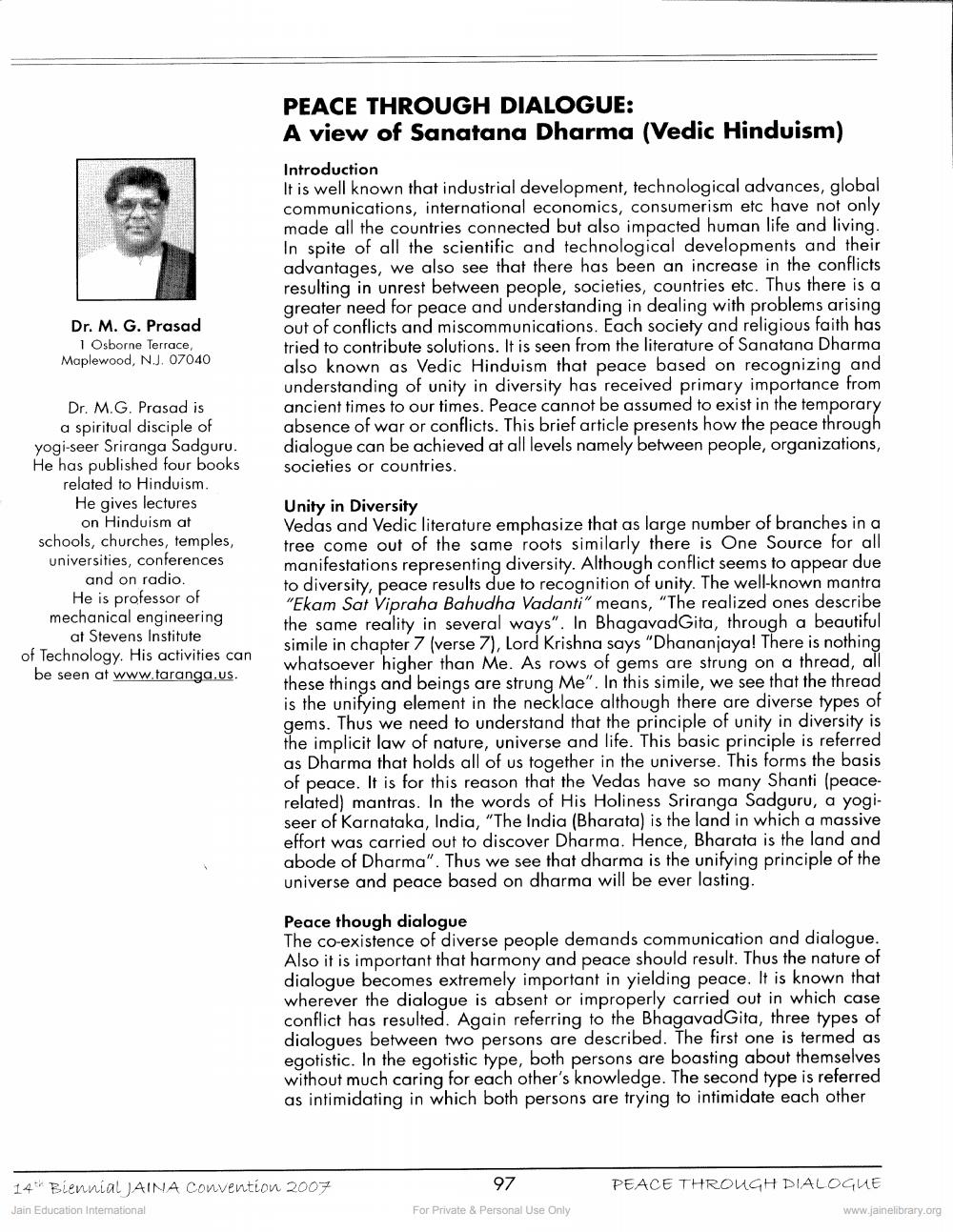________________
PEACE THROUGH DIALOGUE: A view of Sanatana Dharma (Vedic Hinduism)
Dr. M. G. Prasad
1 Osborne Terrace, Maplewood, NJ 07040
Introduction It is well known that industrial development, technological advances, global communications, international economics, consumerism etc have not only made all the countries connected but also impacted human life and living. In spite of all the scientific and technological developments and their advantages, we also see that there has been an increase in the conflicts resulting in unrest between people, societies, countries etc. Thus there is a greater need for peace and understanding in dealing with problems arising out of conflicts and miscommunications. Each society and religious faith has tried to contribute solutions. It is seen from the literature of Sanatana Dharma also known as Vedic Hinduism that peace based on recognizing and understanding of unity in diversity has received primary importance from ancient times to our times. Peace cannot be assumed to exist in the temporary absence of war or conflicts. This brief article presents how the peace through dialogue can be achieved at all levels namely between people, organizations, societies or countries.
Dr. M.G. Prasad is
a spiritual disciple of yogi-seer Sriranga Sadguru. He has published four books
related to Hinduism. He gives lectures
on Hinduism at schools, churches, temples, universities, conferences
and on radio. He is professor of mechanical engineering
at Stevens Institute of Technology. His activities can
be seen at www.taranga.us.
Unity in Diversity Vedas and Vedic literature emphasize that as large number of branches in a tree come out of the same roots similarly there is One Source for all manifestations representing diversity. Although conflict seems to appear due to diversity, peace results due to recognition of unity. The well-known mantra "Ekam Sat Vipraha Bahudha Vadanti" means, "The realized ones describe the same reality in several ways". In Bhagavad Gita, through a beautiful simile in chapter 7 (verse 7), Lord Krishna says "Dhananjaya! There is nothing whatsoever higher than Me. As rows of gems are strung on a thread, all these things and beings are strung Me". In this simile, we see that the thread is the unifying element in the necklace although there are diverse types of gems. Thus we need to understand that the principle of unity in diversity is the implicit law of nature, universe and life. This basic principle is referred as Dharma that holds all of us together in the universe. This forms the basis of peace. It is for this reason that the Vedas have so many Shanti (peacerelated) mantras. In the words of His Holiness Sriranga Sadguru, a yogiseer of Karnataka, India, "The India (Bharata) is the land in which a massive effort was carried out to discover Dharma. Hence, Bharata is the land and abode of Dharma". Thus we see that dharma is the unifying principle of the universe and peace based on dharma will be ever lasting.
Peace though dialogue The co-existence of diverse people demands communication and dialogue. Also it is important that harmony and peace should result. Thus the nature of dialogue becomes extremely important in yielding peace. It is known that wherever the dialogue is absent or improperly carried out in which case conflict has resulted. Again referring to the Bhagavad Gita, three types of dialogues between two persons are described. The first one is termed as egotistic. In the egotistic type, both persons are boasting about themselves without much caring for each other's knowledge. The second type is referred as intimidating in which both persons are trying to intimidate each other
PEACE THROUGH DIALOGUE
14" Biennial JAINA Convention 2007 Jain Education International
For Private & Personal Use Only
www.jainelibrary.org




